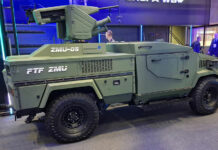Night Attack The Royal Danish Air Force has validated the use of Night Vision Cueing and Display/ Aviator’s Night Vision Imaging System (NVCD/ ANVIS) on its F-16s, offering a night vision enhancement for the daylight functionality provided by standard Joint Helmet Mounted Cueing System (JHMCS). The system was flown for more than 300 hours as part of Operation Unified Protector during the summer of 2011.
The JHMCS developed by Vision Systems International (VSI) provides the pilot with “first look, first shot” high off-boresight weapons engagement capabilities. The system enables the pilot to accurately cue onboard weapons and sensors against enemy aircraft and ground targets without the need to aggressively turn the aircraft or place the target in the Heads-Up Display (HUD) field-of-view for designation. Critical information and symbology, such as targeting cues and aircraft performance parameters, are displayed directly on the pilot’s visor. The main drawback of JHMCS was that it is limited for use in daylight.
The NVCD/ ANVIS system is based on standard ANVIS-F4949 NVGs, modified with a VSI kit, providing the pilot with full JHMCS symbols and cueing capability during night operations with NVGs. The flights conducted were in an RDAF F-16 MLU M5 configuration with no modifications required to the aircraft. According to the RDAF, the tactical information and situational awareness that the system provided was outstanding and provided an efficient merge of Night Vision Goggle (NVG) and Joint Helmet Mounted Cueing System (JHMCS) information.



















